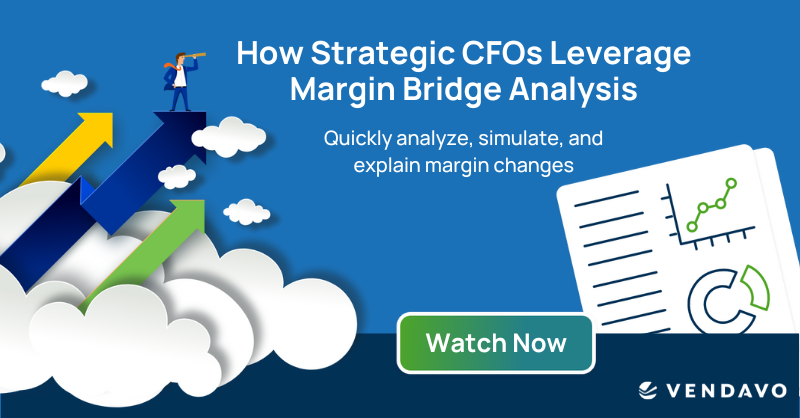What is Margin Management?
Margin management measures and increases a customer’s expansion over time. All the processes and tools that come under the umbrella term should be aimed towards long-term, sustainable profit growth. Doing this well is not only a matter of capitalizing across market conditions, but it also relies on a willingness to reframe internal conversations to be around margins as opposed to only revenue or volumes.
Growing competition coupled with market volatility has re-invigorated interest in margin management, with companies feeling the pressure to find whatever extra profit they can to stay on top.
There was a time when margin management was sidelined in favor of pure cost optimization – a mindset that was instilled during the economic turmoil of ‘08 and ‘09. In today’s hyper-competitive markets, however, a cost-first strategy is no longer sustainable. Instead, putting margin management ahead of cost optimization is the more effective mindset for generating higher profits.
The Pitfalls of Margin Management
Pricing professionals know the theory behind margin management is ostensibly a simple one – higher prices and lower costs mean larger profit margins. The reality, of course, is much more complex.
In practice, companies face a number of considerations before putting a strategy in place. Where can prices be increased without dropping sales? Where can costs be lowered most effectively? Throw in the addition of data and the picture can become even cloudier.
More often than not, companies struggle with margin management because:
- They don’t have the data (or, more precisely, don’t have the tools that provide the right level of data visibility)
- They don’t know what to do with the data (sometimes the result of broken internal processes)
- Margins simply aren’t prioritized outside of the C-suite
Making Margins Matter Enterprise-Wide
In order for margin management strategies to yield the most successful results, all corporate teams need to have a common understanding of margins across the organization. Margin management is as much a culture as it is a process. So, to have a real impact on profitability, it has to matter outside of the C-suite.
A lack of focus on margins managements can lead to misalignments between pricing strategies and desired business outcomes. Sales teams fall back into pricing deals based solely on gut feelings or on relationships with customers, which ends up eating away at margins.
Influencing change is a matter of communication. Business leaders should take meaningful steps to prioritize margin management in order to capture better margin opportunities. As well as explaining why margin management is essential, this means empowering sales teams with the right tools and the right data to fine-tune their gut feelings and yield greater success with pricing strategies.
Discover how one fuel producer realized a €2.3 Million Margin Lift with Vendavo.
Laying the Foundations for Effective Margin Management (and Margin Expansion)
After margin management has been placed on top of the priority list, another common roadblock is knowing where to start with it. Business leaders need to lay a good foundation to build on with a coordinated, margin-focused strategy. What are the elements of that?
Data
Data is the key to margin management. Establishing the right level of visibility helps leaders challenge long-held assumptions and decipher which areas actually drive growth. From a sales perspective, teams equipped with real-time data will close deals at better prices – those without may find themselves lagging behind.
Understanding margin drivers has also become increasingly complicated. Data helps teams understand margin rate and revenue changes as a whole as well as on a transaction-by-transaction basis. Equipped with this knowledge, the challenges of price management and margin optimization become much easier to face.
Intelligent Pricing
Pricing has the most direct impact on profits. Comprehensive margin management strategies recognize the power of pricing in this way and use it to successfully capitalize, even during the most volatile periods.
Traditional approaches to selling and cost-containment can only go so far. Data-lead strategies will help to unlock true pricing potential and drive significant margin improvements. With data-focussed pricing tools, businesses can also place themselves in a much better position to respond to the rapid changes that come with fast-paced modern marketplaces.
Sustained Margin Management: An Essential Part of Long-Term Margin Improvement
The impetus is with business leaders to establish margins as an enterprise-wide priority, empowering teams with tools and data to optimize pricing strategies and implement a margin strategy that aligns with business goals.
In other words, margin management shouldn’t be a periodic process, rather, it should be treated as a continuous, ever-evolving business priority. A crucial part of this is ensuring balance and collaboration between employee awareness (instilling a margin mindset across all teams), data analysis (by extending great data visibility) and action (helping teams make better decisions in order to capture margin-boosting opportunities).
Technology is the secret to success in this respect. Smarter pricing tools provide real-time pricing and margin data, highlight the biggest areas of margin leakage and ensure deals are completed at better prices – all of which create opportunities for more meaningful margin improvements.



